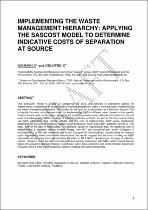 ResearchSpace
ResearchSpace
Implementing the waste management hierarchy: Applying the SASCOST model to determine indicative costs of separation at source
JavaScript is disabled for your browser. Some features of this site may not work without it.
- ResearchSpace
- →
- Research Publications/Outputs
- →
- Conference Publications
- →
- View Item
| dc.contributor.author |
Nahman, Anton

|
|
| dc.contributor.author |
Oelofse, Suzanna HH

|
|
| dc.date.accessioned | 2019-01-16T11:14:04Z | |
| dc.date.available | 2019-01-16T11:14:04Z | |
| dc.date.issued | 2018-10 | |
| dc.identifier.citation | Nahman, A. and Oelofse, S.H.H. 2018. Implementing the waste management hierarchy: Applying the SASCOST model to determine indicative costs of separation at source. Proceedings of the 24th WasteCon's flagship Conference and Exhibition, 15-19 October 2018, Emperor's Palace, Johannesburg | en_US |
| dc.identifier.uri | http://www.wastecon.co.za/programme17th.html | |
| dc.identifier.uri | http://hdl.handle.net/10204/10605 | |
| dc.description | Paper presented at the 24th WasteCon's flagship Conference and Exhibition, 15-19 October 2018, Emperor's Palace, Johannesburg | en_US |
| dc.description.abstract | The SASCOST model is a tool for comparing the costs and benefits of alternative options for implementing a Separation at Source (S@S) recycling programme. S@S is a crucial step in implementing the waste management hierarchy. The model can be used by municipalities as a Decision Support Tool to identify the most cost-effective option for implementing S@S in different areas; based on the specific context of each area. In this paper, we apply the model to provide some indicative information on the unit costs of implementing S@S in a range of different municipal contexts, as well as the total cost of rolling out S@S nationwide. The results indicate that the cost of implementing S@S varies significantly depending on the type of collection system (post separation, truck and trailer, separate vehicle or ‘rich bag’), and on the type of municipality. For example, based on hypothetical data, the additional cost of implementing a separate vehicle system ranges from R17 per household per month (Category A municipalities), to R60 per household per month (Category B4 municipalities); based purely on financial costs. Aggregating these costs to the national level, the results suggest that the costs of rolling out S@S nationwide would range from approximately R4 billion to R6.2 billion, depending on the type of collection system. However, there are also some benefits and savings associated with S@S, which should also be taken into account in decision making. In particular, when socio-economic and environmental impacts are included, there is a big swing toward all systems yielding significant net benefits. | en_US |
| dc.language.iso | en | en_US |
| dc.relation.ispartofseries | Worklist;21702 | |
| dc.subject | Municipal solid waste | en_US |
| dc.subject | Recycling | en_US |
| dc.subject | Separation at source | en_US |
| dc.subject | Kerbside collection | en_US |
| dc.subject | Logistics | en_US |
| dc.subject | Materials recovery facility | en_US |
| dc.subject | Cost-benefit analysis | en_US |
| dc.subject | Modelling | en_US |
| dc.title | Implementing the waste management hierarchy: Applying the SASCOST model to determine indicative costs of separation at source | en_US |
| dc.type | Conference Presentation | en_US |
| dc.identifier.apacitation | Nahman, A., & Oelofse, S. H. (2018). Implementing the waste management hierarchy: Applying the SASCOST model to determine indicative costs of separation at source. http://hdl.handle.net/10204/10605 | en_ZA |
| dc.identifier.chicagocitation | Nahman, Anton, and Suzanna HH Oelofse. "Implementing the waste management hierarchy: Applying the SASCOST model to determine indicative costs of separation at source." (2018): http://hdl.handle.net/10204/10605 | en_ZA |
| dc.identifier.vancouvercitation | Nahman A, Oelofse SH, Implementing the waste management hierarchy: Applying the SASCOST model to determine indicative costs of separation at source; 2018. http://hdl.handle.net/10204/10605 . | en_ZA |
| dc.identifier.ris | TY - Conference Presentation AU - Nahman, Anton AU - Oelofse, Suzanna HH AB - The SASCOST model is a tool for comparing the costs and benefits of alternative options for implementing a Separation at Source (S@S) recycling programme. S@S is a crucial step in implementing the waste management hierarchy. The model can be used by municipalities as a Decision Support Tool to identify the most cost-effective option for implementing S@S in different areas; based on the specific context of each area. In this paper, we apply the model to provide some indicative information on the unit costs of implementing S@S in a range of different municipal contexts, as well as the total cost of rolling out S@S nationwide. The results indicate that the cost of implementing S@S varies significantly depending on the type of collection system (post separation, truck and trailer, separate vehicle or ‘rich bag’), and on the type of municipality. For example, based on hypothetical data, the additional cost of implementing a separate vehicle system ranges from R17 per household per month (Category A municipalities), to R60 per household per month (Category B4 municipalities); based purely on financial costs. Aggregating these costs to the national level, the results suggest that the costs of rolling out S@S nationwide would range from approximately R4 billion to R6.2 billion, depending on the type of collection system. However, there are also some benefits and savings associated with S@S, which should also be taken into account in decision making. In particular, when socio-economic and environmental impacts are included, there is a big swing toward all systems yielding significant net benefits. DA - 2018-10 DB - ResearchSpace DP - CSIR KW - Municipal solid waste KW - Recycling KW - Separation at source KW - Kerbside collection KW - Logistics KW - Materials recovery facility KW - Cost-benefit analysis KW - Modelling LK - https://researchspace.csir.co.za PY - 2018 T1 - Implementing the waste management hierarchy: Applying the SASCOST model to determine indicative costs of separation at source TI - Implementing the waste management hierarchy: Applying the SASCOST model to determine indicative costs of separation at source UR - http://hdl.handle.net/10204/10605 ER - | en_ZA |





